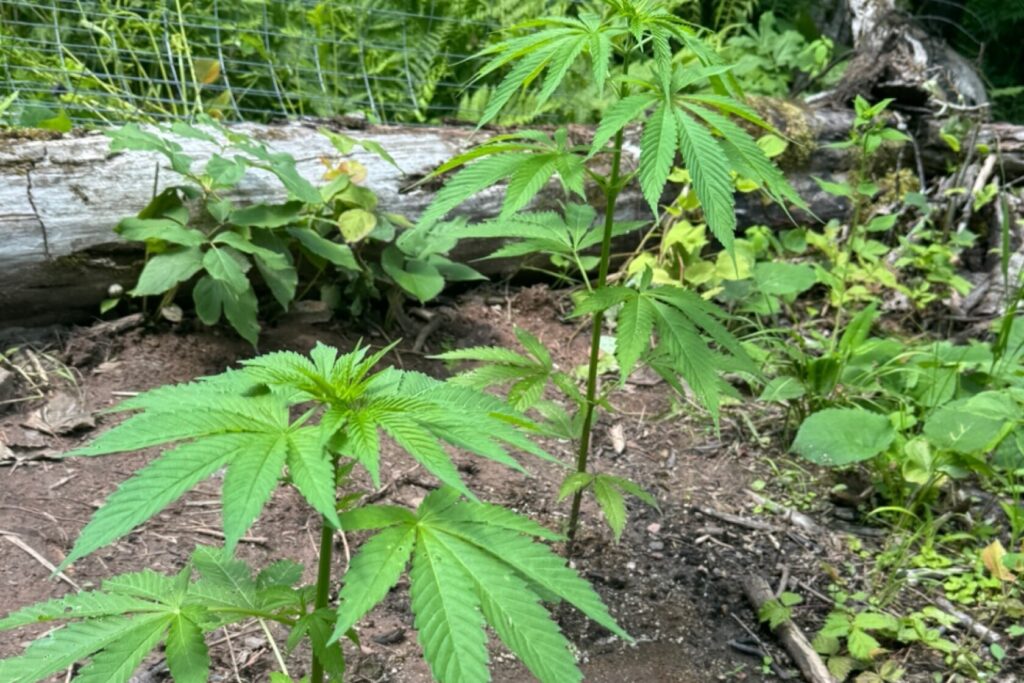By early October, I could smell the skunkiest pot plant from 40 yards away, growing in the enclosed garden, sporting thick buds covered in what looked like frost but were actually sticky plant parts laden with the intoxicant THC.
I’d lost my taste for marijuana in about the year 2000 but was beguiled by the novelty of legal weed after a lifetime of prohibition. I celebrated my new rights as a Minnesotan by buying several cannabis seeds and planting them in my garage in May under a grow light alongside tomatoes and cucumbers.
I divided the hardened-off seedlings into two sunny openings in my woods. As of 2023, Minnesota law says anyone over age 21 may grow up to eight cannabis plants (only four may be flowering at one time) at their primary residence if the plants are “in an enclosed, locked space that is not open to public view.”
My township woods were well out of view, and I had plenty of fencing on hand, too, for the insatiable deer that consumed greenery with a gusto rivaling Bob Marley. I slapped a padlock on my fenced plants and became a legal cannabis grower.
By July, two plants in a drier meadow were growing burly stems and spitting out new whirls of the iconic, deeply compound leaves. Soon they towered over the surrounding blue-joint grass and wild raspberry cane.
I was growing three varieties of indica. The marijuana genus Cannabis has two subspecies: indica and sativa. The flower on a sativa like Maui Wowie won’t mature outdoors during a Zone 4 Duluth growing season. Indica, the Latin name referring to the plant’s subcontinent origin, flowers faster. The indica looked identical but created distinctive smells.
Ryan Rodgers grows three varieties of indica, a subspecies of cannabis.
A high-potency kind called O.G. Kush emitted a powerful piney aroma. To get a citrusy whiff from a milder variety, dubbed Euphoria, I had to bury my nose in its leaves. I’d transplanted a struggling third plant into the vegetable garden where it recovered and began to stink like the skunk whose nightly perambulation passed beneath my bedroom window.
The seeds I bought were supposed to produce only female plants. Like an aspen tree, pot plants are dioecious and have separate male and female individuals.
When growing to produce intoxicating flowers, male plants are the enemy. Cannabis is wind-pollinated, and if a male plant is too near, the female flower will develop seeds as its THC levels plummet. An unpollinated female flower, on the other hand, will stay seedless and grow heavy with THC.
Signaled by ebbing daylight hours, my plants began flowering in August. The flowers at first were just wispy tendrils growing at the ends of branches modestly thickening with chunky growth. After some weeks, though, with a 10x magnification hand lens, I could admire spheres like microscopic dewdrops forming on the fattening flowers.
These were trichomes, a feature of certain plant species (like the carnivorous sundew, whose trichomes trap insects so the plant may eat them). In cannabis, the bulk of psychoactive chemicals develop in the trichomes. The droplets slowly grew stalks and rose from the buds like tiny mushrooms. As the fall deepened, the formerly crystalline trichomes clouded and the translucent flower tendrils curled and turned orange.
The ideal time to harvest is when the trichomes begin turning from milky white to amber. In late September, my trichomes were just turning milky. Frost was late, but I was worried about mold, which a friend warned could quickly destroy a crop during long, damp nights, so I cut the two best plants and hung them in my garage to dry.
H/T: www.duluthnewstribune.com
You can view the whole article at this link Home marijuana-growing experiment produces herby verve



